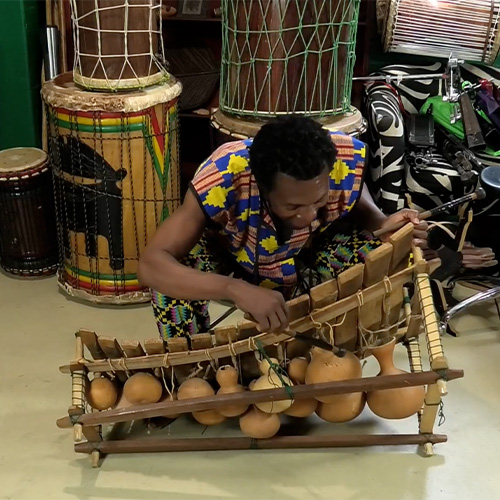Y1. Lesson 32. Cultures - Music from Ghana
Prior learning:
Duration: 30 minutes
Materials:
Keywords: Beat, rhythm, singing, chanting, partners, rhymes, circle games.
Difficulty: ![]()
Prepare
Present
Music from Ghana
Practise
so, mi, la - ta & ti-ti
 Melodic development
Melodic development
![]() Students read and sing the solfa patterns.
Students read and sing the solfa patterns.
- Students are seated and attentive.
- Project the solfa sheet to the left on the board.
- Explain that the class will sing the solfa patterns, ensuring they also keep the rhythm.
- Sing the solfa note so, pointing to the first pattern's symbols and asking students to copy you as you sing the first pattern.
- Students will repeat without you singing.
- If you use hand signs, this will be a valuable tool to guide the students silently.
- When secure, move on to the following pattern and repeat the process for subsequent patterns.
- These exercises help improve students' sense of pitch, rhythm, and sight reading.

 Rhythmic development
Rhythmic development
![]() Students read and clap back the rhythm patterns to two well-known songs.
Students read and clap back the rhythm patterns to two well-known songs.
- Students are seated and attentive.
- Project or print the rhythm chart for the two songs.
- Ask students to clap the first line of the first song [Lucy Locket]
- Ask if they recognise the song by the rhythm pattern alone.
- If the class struggles, hum the first few notes to assist.
- The class should clap the whole song back to you.
- When secure, ask them to clap and sing the melody.
- Repeat with the next song [Let us chase the Possum].
 Creative movement
Creative movement
![]() Students take turns in jumping over a candlestick prop.
Students take turns in jumping over a candlestick prop.
- Lead the class in singing the song. The 6/8 time signature is unconsciously present.
- When secure, you can use several candlesticks or similar objects as a "candle." Place them on the ground.
- Students are divided into four teams and lined up a few feet away from each candlestick.
- While singing the song, students will, in turn, jump over the candles.
- Once a student has jumped over the candlestick, they will turn around and do it again and return to the end of the line.
 Questions
Questions
- What do you think the word nimble means?
- What did Jack have to do?
- What else could Jack have jumped over?
 Listening
Listening
![]() Students watch and listen to a xylophone player from Ghana.
Students watch and listen to a xylophone player from Ghana.
- Students are seated. Have a classroom xylophone on your desk.
- Tell the class they will watch a musician from Ghana playing an instrument from his country.
- Explain that Ghana is an African country and show the world map. Point out Ghana.
- Play the two videos. When finished, ask the students what instrument he was playing. [xylophone].
- Ask students if this xylophone looks the same as a classroom instrument. What are the differences? [curved shape, gourds under the bars]
- Explain to students what a gourd is and where it is found.
- Ask students what the objects under the xylophone are and why they are there [to make the sound louder and brighter]
- Draw attention to the two images of xylophones below under Visual Learning.
 Visual learning
Visual learning
![]() Students discover that xylophones from Ghana are made from gourds.
Students discover that xylophones from Ghana are made from gourds.
Xylophones from Ghana use gourds as resonators to amplify and shape the sound produced by the wooden keys. Gourds are used because they have a unique acoustic property that enhances the sound quality of the xylophone.


When a wooden key is struck on a xylophone, it produces a sound with a relatively short decay time. This means that the sound fades away quickly, and it can be challenging to hear the subtleties and nuances of the music.
By attaching a gourd underneath each key, the sound produced by the wooden key is amplified and resonates within the gourd, giving the sound a richer and fuller quality. The shape of the gourd also acts as a natural equaliser, emphasising certain frequencies and reducing others, resulting in a more balanced sound.
Additionally, using gourds in xylophones is deeply rooted in cultural and traditional practices. In many African cultures, gourds have been used for centuries as musical instruments and resonators, making them an integral part of the musical tradition in Ghana.
 Part work
Part work
![]() Students improve their recognition of rhythmic syllables by singing and writing the symbols.
Students improve their recognition of rhythmic syllables by singing and writing the symbols.
- Lead the class in singing and clapping the rhythm of the words.
- When secure, use the time names to replace the lyrics and ask students to clap and sing the time names of ti-ti and ta.
- Ask a volunteer to come forward and draw the time names on the board for the first line of 'Let us chase the possum'.
- Repeat with other volunteers for the remaining three lines.
 Questions
Questions
- What is a possum?
- Possums can live in gum trees. What other animals live in gum trees? [Koalas]
 Assess
Assess
Suggested lessons
Y1. Beat II

Y1. Beat III

Y1. Beat IV

